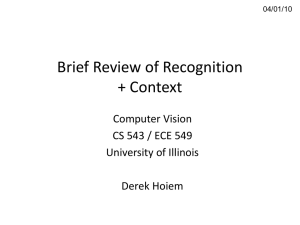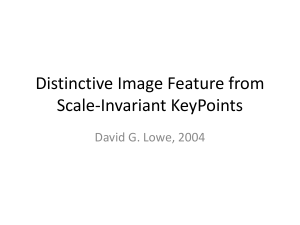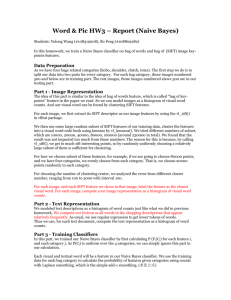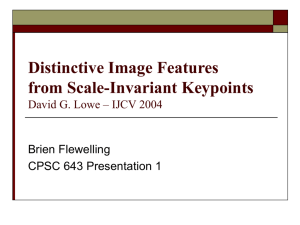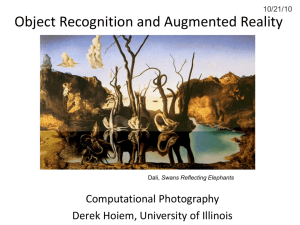Home Interior Classification using SIFT Keypoint Histograms
advertisement
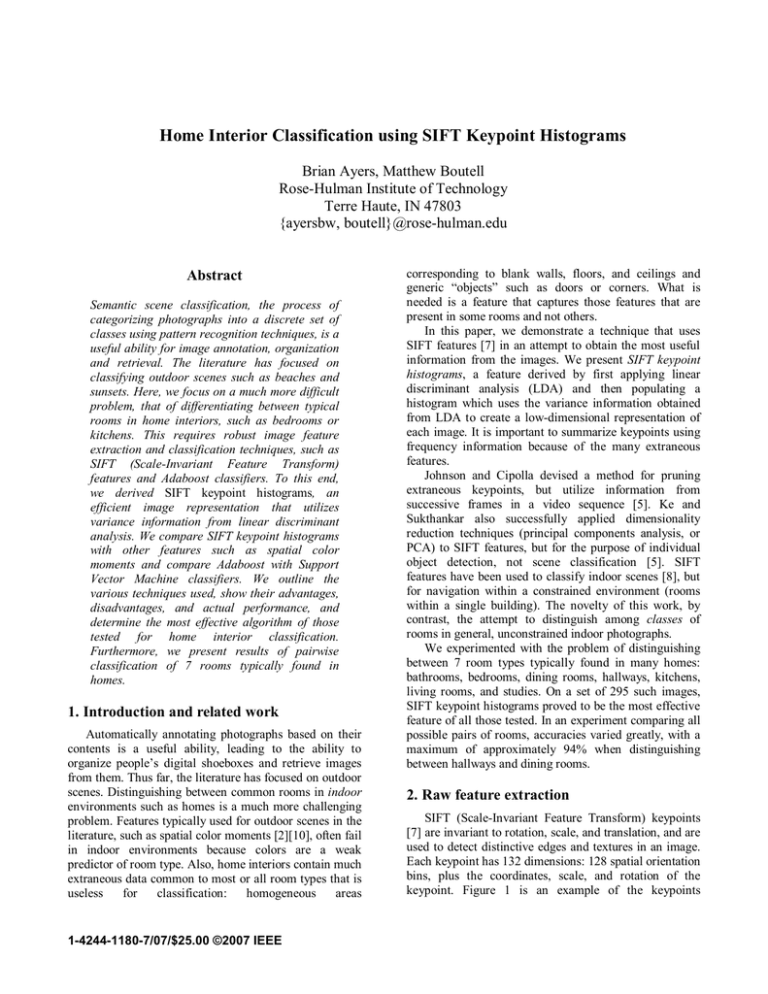
Home Interior Classification using SIFT Keypoint Histograms
Brian Ayers, Matthew Boutell
Rose-Hulman Institute of Technology
Terre Haute, IN 47803
{ayersbw, boutell}@rose-hulman.edu
Abstract
Semantic scene classification, the process of
categorizing photographs into a discrete set of
classes using pattern recognition techniques, is a
useful ability for image annotation, organization
and retrieval. The literature has focused on
classifying outdoor scenes such as beaches and
sunsets. Here, we focus on a much more difficult
problem, that of differentiating between typical
rooms in home interiors, such as bedrooms or
kitchens. This requires robust image feature
extraction and classification techniques, such as
SIFT (Scale-Invariant Feature Transform)
features and Adaboost classifiers. To this end,
we derived SIFT keypoint histograms, an
efficient image representation that utilizes
variance information from linear discriminant
analysis. We compare SIFT keypoint histograms
with other features such as spatial color
moments and compare Adaboost with Support
Vector Machine classifiers. We outline the
various techniques used, show their advantages,
disadvantages, and actual performance, and
determine the most effective algorithm of those
tested for home interior classification.
Furthermore, we present results of pairwise
classification of 7 rooms typically found in
homes.
1. Introduction and related work
Automatically annotating photographs based on their
contents is a useful ability, leading to the ability to
organize people’s digital shoeboxes and retrieve images
from them. Thus far, the literature has focused on outdoor
scenes. Distinguishing between common rooms in indoor
environments such as homes is a much more challenging
problem. Features typically used for outdoor scenes in the
literature, such as spatial color moments [2][10], often fail
in indoor environments because colors are a weak
predictor of room type. Also, home interiors contain much
extraneous data common to most or all room types that is
useless
for
classification:
homogeneous
areas
1-4244-1180-7/07/$25.00 ©2007 IEEE
corresponding to blank walls, floors, and ceilings and
generic “objects” such as doors or corners. What is
needed is a feature that captures those features that are
present in some rooms and not others.
In this paper, we demonstrate a technique that uses
SIFT features [7] in an attempt to obtain the most useful
information from the images. We present SIFT keypoint
histograms, a feature derived by first applying linear
discriminant analysis (LDA) and then populating a
histogram which uses the variance information obtained
from LDA to create a low-dimensional representation of
each image. It is important to summarize keypoints using
frequency information because of the many extraneous
features.
Johnson and Cipolla devised a method for pruning
extraneous keypoints, but utilize information from
successive frames in a video sequence [5]. Ke and
Sukthankar also successfully applied dimensionality
reduction techniques (principal components analysis, or
PCA) to SIFT features, but for the purpose of individual
object detection, not scene classification [5]. SIFT
features have been used to classify indoor scenes [8], but
for navigation within a constrained environment (rooms
within a single building). The novelty of this work, by
contrast, the attempt to distinguish among classes of
rooms in general, unconstrained indoor photographs.
We experimented with the problem of distinguishing
between 7 room types typically found in many homes:
bathrooms, bedrooms, dining rooms, hallways, kitchens,
living rooms, and studies. On a set of 295 such images,
SIFT keypoint histograms proved to be the most effective
feature of all those tested. In an experiment comparing all
possible pairs of rooms, accuracies varied greatly, with a
maximum of approximately 94% when distinguishing
between hallways and dining rooms.
2. Raw feature extraction
SIFT (Scale-Invariant Feature Transform) keypoints
[7] are invariant to rotation, scale, and translation, and are
used to detect distinctive edges and textures in an image.
Each keypoint has 132 dimensions: 128 spatial orientation
bins, plus the coordinates, scale, and rotation of the
keypoint. Figure 1 is an example of the keypoints
extracted from a photograph of a hallway using SIFT.
SIFT features do not take color into account, but for the
purposes of this problem, color is not very useful.
Spatial color moments are a state-of-the-art feature
used to distinguish outdoor scenes [2][10]; we use them
as a baseline feature for comparison, even though color is
expected to be more salient for outdoor scenes than
indoor ones. As in [2], we convert the image to LST space
and split the image into blocks formed by an NxN grid.
We then compute the mean and variance of each block’s
color band. We use a 4x4 grid in our tests, yielding a 16 x
3 x 2 = 96-dimension feature.
dimensionality reduction, and distance-based pruning,
class-based pruning, k-means clustering, and histograms
to reduce the number of keypoints. We discuss the most
successful approaches in this section, reserving discussion
of the other choices for the Appendix.
3.1 Dimensionality reduction
Linear discriminant analysis (LDA) [3] exploits class
information, maximizing between-class scatter, measured
by scatter matrix SB, while minimizing within-class
scatter, measured by scatter matrix SW. This is done by
maximizing the ratio:
J ( w) =
wt S B w
w t SW w
(1)
over projection vectors w.
LDA reduces the data set to a dimensionality equal to
one fewer than the number of classes, C. The (C-1)
dimensions are sorted by the amount of the data set’s
variance they capture. As expected, LDA improved
classification accuracy significantly on this problem
(Figure 2).
Figure 2: The first 2 dimensions of the data after
performing LDA on it, color coded by class.
Figure 1: SIFT keypoints for a photo of a hallway.
Note how most of the SIFT keypoints are located in the
bottom left corner, where they cover a piece of cardboard.
Unfortunately, they do not help classify the room.
3. Data reduction
Each photograph in our collection typically contains
over 1000 SIFT keypoints, each with 132 dimensions.
One way to use these keypoints for scene classification is
to classify each keypoint independently, and then classify
the image with the same class assigned to the majority of
its keypoints. In our set of approximately 300 images, this
means over 300,000 keypoints will be classified, many of
which do not vary much per image. Therefore, we needed
to reduce dimensionality or prune the number of detected
keypoints per image before using them for classification.
We tried multiple approaches to this: PCA and LDA for
3.2 Keypoint histograms
Dimensionality reduction does not take into account
the many extraneous features common to all of the
images. Our attempts to prune keypoints, documented in
the Appendix, were mostly unsuccessful. An alternative
to classifying each keypoint independently is to create a
keypoint histogram for each image from the 1000+
keypoints detected in that image. This technique allows
the relationships between numbers and types of keypoints
in an image to be extrapolated.
We started by applying LDA to each keypoint, as
discussed in Section 3.1. For the 7-class problem
described in the introduction, this yielded 6 dimensions
for each keypoint. Histograms typically have high
dimension to preserve granularity of the input, which
causes classification, particularly on small data sets, to
suffer from the so-called “curse of dimensionality”. To
maximize granularity while keeping a small number of
dimensions, we optimized the allotment of bins by data
variance, allocating a higher number of bins to those
dimensions that exhibited higher variance on the data set,
as calculated by the LDA algorithm. Specifically, the
number of bins for each dimension was chosen to be
approximately proportional to the data variance in that
dimension, since dimensions with a higher variance
required more bins to faithfully represent the data. We
found experimentally that performance was highest when
the dimension with the highest variance had an even
number of bins, as this likely helped to split the data apart
in its densest area, the center. We found that a 48dimension histogram with 4, 3, 2, and 2 bins for
dimensions 1-4 was the most effective. Note we ignored
the 2 least important dimensions due to the small size of
our data set. For larger data sets, one can increase the
number of dimensions some while avoiding the curse of
dimensionality. But for this set, our choice of histogram
allowed for the maximum preservation of information in
the histogram without sacrificing performance.
4. Classifiers
We experimented with three classifiers: a nearest
mean classifier, support vector machines (SVM), and
Adaboost.
Of these three, the nearest mean classifier is the
simplest and is also the only one that does not use
keypoint histograms. We start by breaking the SIFT
keypoints found for each class into a number of clusters
using an adaptive k-means algorithm described in the
Appendix. We then represent each class by the means of
its set of clusters. The nearest mean classifier then lets
every SIFT keypoint in a test image cast a vote for the
class that has the closest mean to it. The test image is
classified as the class with the most votes in the image.
Figure 3 shows an example of the clusters formed
from SIFT keypoints extracted from the bathroom images.
Support vector machines are more robust than the
previous classifier. SVMs find a hyperplane that
maximizes the margin between the classes. Kernel
functions are used to project the data to a higher
dimension to make the data more easily separable in that
dimension; we used the radial basis function (RBF)
kernel.
The final classifier used was Adaboost (Adaptive
Boosting) [4]. Adaboost works by consulting and
weighting various weak learners (which are any type of
simple classifier that has a classification rate above 50%);
we used decision stumps. It iteratively trains each weak
learner on randomly-chosen subsets of the training data
and then compares their accuracy for classification. The
weak learners that are more accurate are weighted higher
than others. We used the ModestBoost variant [11] in our
tests.
Figure 3: The keypoints of a bathroom image are clustered
into 3 different groups by using K-means segmentation.
The original image is shown (top left) along with the 3
different clusters of keypoints, each in their own image.
Adaboost seems to be the most useful classifier for
this problem. It is particularly resilient to over-fitting, and
consumes less memory than SVM, another important
point when SIFT keypoints tend to be numerous.
5. Experimental results
The test set consists of 295 images (30 bathrooms, 85
bedrooms, 41 dining rooms, 23 hallways, 50 kitchens, 43
living rooms, and 23 offices or studies) collected from a
variety of online sources, such as realtor websites. Images
with people in them or with other anomalies such as black
borders around the image were filtered out. We attempted
to acquire a wide-range of images from each room type.
All tests used leave-one-out cross validation.
The first test compared feature and classifier
combinations, namely (1) color moments with SVM, (2)
keypoints reduced by LDA with nearest means, (3)
keypoint histograms with SVM, and (4) keypoint
histograms with Adaboost. In general, keypoint
histograms with Adaboost performed best. For the full 7
class problem, they correctly classified the images 38.1%
of the time. This is much higher than the baseline
obtained by using color moments, 23.8%, and the
theoretical random, 14.3%. It is also significantly higher
than the accuracy obtained using SIFT features with other
classifiers: SVM (33.7%) and nearest-means (32.3%)
We then performed the same test while varying the
number of rooms, n, between which to distinguish (Figure
4). For each value of n, we repeated a test in we chose n
rooms and then trained a classifier to distinguish between
those n rooms. When the number of classes is reduced, all
features and classifiers had a higher-than-random
accuracy in every trial, and keypoint histograms with
Adaboost always had the highest accuracy. For the 2 class
problems, they had a 77.7% classification accuracy
overall.
Accuracy (%)
Mean Accuracy
80
70
60
50
40
30
20
10
0
2
3
4
5
Keypoint
Hist. +
Adaboost
Keypoint
Hist. +
SVM
Color
Mom ents
+ SVM
Keypoints
+ Nearest
Mean
Random
Number of classes
Figure 4: Mean accuracy of each type of classification
technique (along with the theoretical random classification rate
for comparison) for different numbers of randomly selected
classes.
Once determining which features and classifiers work
best, an interesting question to ask is which rooms were
easiest and most difficult to classify. We therefore ran a
second experiment in which we performed binary
classification on all pairs of classes. We first precomputed
the keypoint histograms for all images. We then selected
two rooms and trained an Adaboost classifier on all the
images from those two rooms. We found a great deal of
variance in the classification accuracy depending on the
two room types being compared (Table 1). The rooms
with the most similar SIFT keypoints were studies and
living rooms; this was the only pair that performed worse
than random. Hallways and dining rooms proved to be the
easiest for the classifier to tell apart, having almost 94%
classification accuracy. This makes sense, given the
similarity between the objects in living rooms and studies
(both have chairs, tables, etc) versus the extreme
difference between hallways and living rooms (only flat
walls and doors in hallways).
Figure 5 contains examples of images that were
successfully or unsuccessfully classified. The first image
contains all of the classic features of a living room and
would be expected to be correctly classified, although the
second correct living room image classification is
surprising, since the only entirely visible object is the
fireplace. We conjecture that the failed living room
classification is because the many shadows on the floor
add too much noise to the keypoint histogram. The
bedroom image on the left is clearly dominated by the
bed, probably explaining its successful classification. The
image on the right, classified incorrectly, shows a great
deal of variance from the typical bedroom in its details.
The many extra objects and frills likely made the keypoint
histogram too noisy for a correct classification, much like
the shadows in the living room example. Although the
classifier has a difficult time with extravagant or poorly
photographed rooms that vary too far from the “average”
room of that class, it does allow for a fair deal of variance,
as shown in the middle bedroom image.
7. Conclusions and future work
Indoor room classification was shown to be extremely
difficult using low-level features. SIFT keypoint
histograms classified using Adaboost were to be the most
robust classification algorithm of those tested, achieving
accuracy approximately twice that obtained by chance.
While still unable to perform highly accurately on the full
7 class problem, they achieve a respectable accuracy with
2 and 3 classes.
Future work involves using spatial information
explicitly. An attempt to spatially cluster SIFT features in
an image could allow for finding objects in a room; for
instance, a chair in front of a blank wall would be
spatially clustered together as an object. These clusters
are a type of semi-supervised object detector [9]; some
clusters of similar types within each class would
correspond to the objects that are in most images of that
room type. Finding these in a novel image would then be
evidence for that room type, particularly in rooms that
tend to be defined by the presence of a few objects.
Alternately, an explicit object-finding approach (using
domain-specific detectors for tables, beds, sinks, etc),
followed by probabilistic scene modeling, as was done
with outdoor scenes [1], may prove be more powerful.
References
[1] M. Boutell, J. Luo, and C. Brown. Factor-graphs for
region-based whole-scene classification. In Proc
International Workshop on Semantic Learning Applications
in Multimedia (in conjunction with CVPR2006), New York,
NY, 2006.
[2] M. Boutell, A. Choudhury, J. Luo, and C. Brown. Using
semantic features for scene classification: How good do
they need to be? In Proc IEEE International Conference on
Multimedia and Expo, Toronto. 2006.
[3] R. Duda, R. Hart, and D. Stork. Pattern Classification.
John Wiley and Sons, Inc., New York, 2001.
[4] Y. Freund and R. E. Schapire. A decision-theoretic
generalization of on-line learning and an application to
boosting. In Proc. Second European Conference on
Computational Learning Theory, 1995. p. 23-37.
Bedroom
Bathroom
Bedroom
Dining Room
Hallway
Kitchen
Living Room
Office/Study
74.8
Dining
Room
80.0
85.6
Hallway
Kitchen
X
85.2
93.7
60.0
85.2
80.0
82.2
Living
Room
83.6
70.3
69.9
83.3
66.7
Office or
Study
X
85.2
79.4
X
71.2
62.1
Table 1: Classification accuracy (%) using SIFT keypoint histograms with Adaboost for each pair of rooms. The three pairs that
had too few images to test are marked with an X.
Success
Success
Failure
Success
Success
Failure
Figure 5: Samples of successful and unsuccessful classifications on the full 7-class problem. The first row contains living room
photos, while the second row contains bedroom photos.
[5] M. Johnson and R. Cipolla, Stable interest points for
improved image retrieval and matching. Tech. Report
TR20060916, University of Cambridge, Cambridge, UK,
2006.
[6] Y. Ke and R. Sukthankar. PCA-SIFT: A more distinctive
representation for local image descriptors. In Proc IEEE
Internation Conference on Computer Vision and Pattern
Recognition, Washington, D.C., 2004.
[7] Lowe, D. G. Distinctive image features from scaleinvariant keypoints. International Journal of Computer
Vision, 60, 2: 91-110 (2004).
[8] L. Ledwich and S. Williams. Reduced SIFT features for
image retrieval and indoor localisation. In Proc.
Australasian Conf. on Robotics and Automation (ACRA),
2004.
[9] C. Rosenberg and M Hebert. Training object detection
models with weakly labeled data. In Proc. British Machine
Vision Conference, 2002.
[10] A. Vailaya, M. Figueiredo, A. Jain, and H. J. Zhang.
Content-based hierarchical classification of vacation
images. In Proc. IEEE Multimedia Systems, 1999.
[11] A. Vezhnevets, V. Vezhnevets Modest AdaBoost Teaching AdaBoost to generalize better. Graphicon-2005,
Novosibirsk Akademgorodok, Russia, 2005.
Appendix: Other data reduction options
Here we briefly document a number of alternative
dimensionality-reducing and clustering algorithms that we
tried.
Principal components analysis (PCA) [3] can be used
to reduce the dimensionality of the data, as done by Ke
and Sukthankar [5]. PCA uses the eigenvectors of the
covariance matrix of all the feature vectors to re-orient the
coordinate system to maximize the variance using the
fewest number of dimensions. The dimensions are sorted
by the amount of variance exhibited in that dimension.
Applying PCA on our data set reduced the dimensionality
to under 50% of the original while still preserving
approximately 90% of the data variance. (It could further
reduce the dimensionality to under 20% of the original
while keeping about 80% of the variance.) However,
since PCA does not take class information into account, it
was not very effective.
As stated in Section 3.2, dimensionality reduction
does not take into account the many extraneous features
common to all of the images. In an attempt to remove as
many of those as possible, we first employed a simple
distance-based data pruning algorithm. Any pair of SIFT
features with distances in the feature space below a
threshold were both removed completely. This caused any
large clusters of SIFT features, which we assumed to be
common to all classes, to be removed (Figure 6).
Although this slightly helped classification, it didn’t solve
the problem.
To incorporate class information into the pruning
process, we improved the pruning algorithm using a
heuristic scoring system. Each point is assigned a score
based on the points surrounding it. Each neighboring
point that belongs to the same class contributes +1 to its
score, while those that belong to a different class
contribute -1. Once this is complete, only points that have
a higher score than all their neighbors of a different class
are retained; the rest are pruned. This allowed for classes
to cluster their features in regions where they are most
predominate. However, this was also insufficient, as it
tended to allow one class to “take over” (Figure 7).
We also used K-means segmentation to find useful
clusters of data, so that clusters could be represented by
their means. K-means segmentation is an algorithm that
divides the data into k clusters. We used an adaptive
version of the algorithm that determines the optimal k
value using distance thresholds for the minimum and
maximum sizes of clusters, creating or destroying clusters
as needed. In general, 2 to 7 clusters were found in each
class. Although clustering proved to be ineffective for
enhancing the keypoint data-set, it was useful as part of
the nearest-mean classifier described in Section 4.
Figure 6: The first 2 dimensions of the data after
performing LDA on it. (Left) The original data, repeated
from Figure 2, color coded by class. (Right) After distancebased pruning.
Figure 7: The original data (left) is pruned using the classbased pruning system, yielding the image on the right.
Note how the class colored as black has taken over a
significant part of the space.
